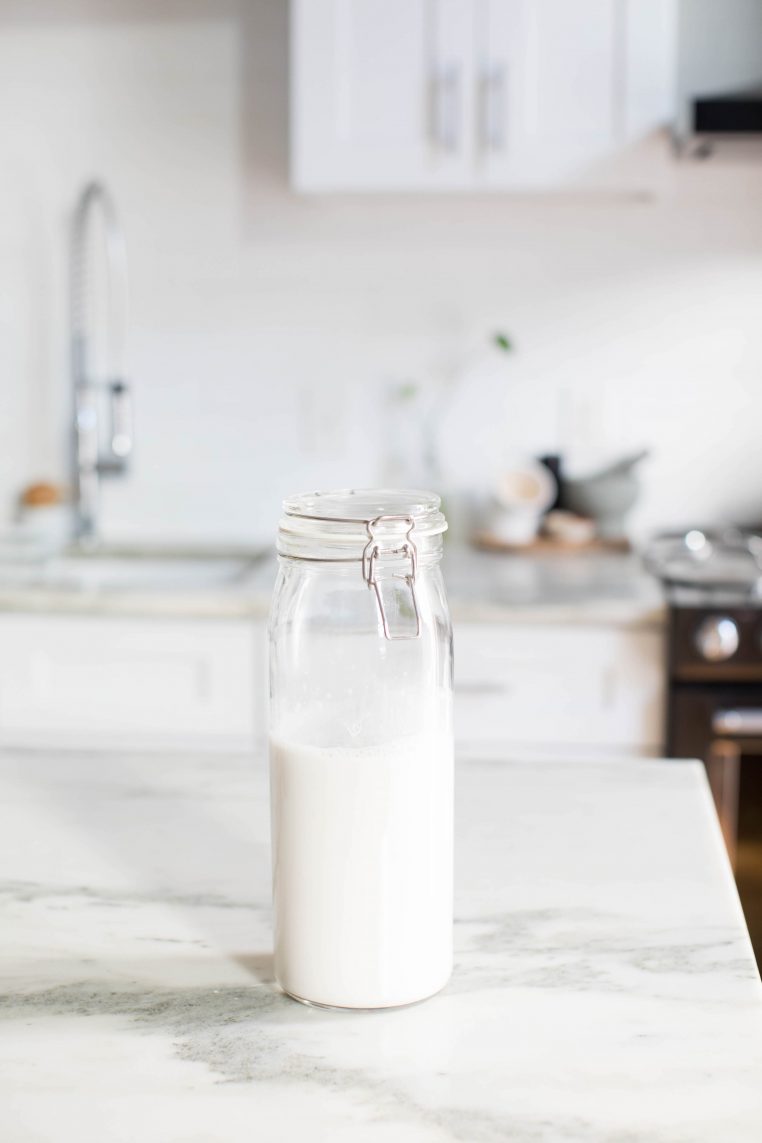Got milk? Despite what advertisers would like to have you believe, there are plenty of dairy-free calcium sources out there that can help promote better bone health.
Thanks to the classic marketing campaigns and catchy slogans that have blasted on our televisions and radios for years, most of us have grown up believing that milk builds strong bones. And with the dairy industry pumping millions of dollars into lobbying for control over the nation’s nutrition policies, it’s no wonder that most of us consider dairy to be an integral ingredient for bone health (1).
While it’s true that milk and other dairy products are a great source of calcium and other important nutrients like protein, vitamin D, vitamin B12, and phosphorus, dairy is definitely not a must-have on a healthy diet. In fact, there are several ethical, environmental, and health reasons you may actually want to consider limiting your intake of dairy. Furthermore, enjoying a well-rounded, nutritious diet rich in nuts, seeds, veggies, and legumes can supply all of the important vitamins and minerals found in dairy.
This article will take a closer look at some of the issues associated with dairy consumption, plus some of the top sources of calcium that are both dairy-free and delicious.
What Is Calcium and Why Is It Important?
When you think of calcium, bone health may be the first thing that comes to mind. As the most abundant mineral in the human body, more than 99% of the body’s calcium is found in the bones and teeth (2). For this reason, getting enough calcium in your diet—along with other micronutrients like vitamin D, phosphorus, and vitamin K—is absolutely essential for preventing fractures and protecting against bone loss.
But although calcium is most well-known for providing bones with their signature strength and structure, it’s involved in several other aspects of health as well. In fact, calcium is also necessary for muscle contraction, nerve transmission, hormone secretion, blood pressure regulation, and heart health (3).
Low levels of calcium, also known as hypocalcemia, can cause symptoms like muscle spasms, cramps, numbness, weakness, tingling, and seizures (4). Fortunately, calcium is found in a variety of different food sources, making it easy to meet your daily needs for this important mineral.
6 Reasons You Don’t Need Dairy For Calcium
There are several reasons why dairy may not be a great dietary addition for everyone. Here are a few factors you may want to consider when determining whether or not you’d like to include dairy in your diet.
1. Some people can’t tolerate it
One of the main problems with dairy is that it contains lactose, a type of simple sugar found in milk. According to one study, approximately 75% of the global population loses the ability to digest lactose at some point, resulting in a condition known as lactose intolerance (5). Lactose intolerance can cause a number of adverse side effects, including stomach cramps, bloating, gas, and indigestion.
Therefore, while dairy can be a simple way to increase calcium intake for some, there are many others who may be unable to tolerate it. Fortunately, for those with lactose intolerance, there are plenty of other calcium-rich milk alternatives available that can be enjoyed instead.
2. It’s high in saturated fat
Dairy products like milk, yogurt, cheese, and butter are all typically high in saturated fat. Although saturated fat is an important component of cell membranes and associated with several different health benefits (including a lower risk of death from stroke and higher levels of good HDL cholesterol), it’s still important to keep your intake in moderation (6, 7, 8).
Overdoing it on the saturated fat could increase levels of LDL cholesterol, which is linked to a higher risk of heart disease (9). Higher saturated fat intake has also been associated with reductions in bone density and decreases in calcium absorption, which may negate many of the potential health benefits of dairy (10, 11). The most recent Dietary Guidelines for Americans recommends limiting saturated fat intake to less than 10% of total daily calories (12).
3. Dairy may be linked to a higher risk of certain cancers
Several observational studies have found that dairy consumption could be associated with a higher risk of developing certain types of cancer. In particular, research shows that dairy consumption could be associated with a higher risk of stomach cancer and prostate cancer (13, 14).
However, keep in mind that these studies show an association, but don’t necessarily mean that dairy directly causes these forms of cancer. Furthermore, several other studies have turned up conflicting findings, reporting that dairy could even be linked to a lower risk of some types of cancer, including breast cancer and colorectal cancer (15, 16). Therefore, more research is needed to evaluate the potential role that dairy may play when it comes to cancer development.
4. It could worsen acne for some people
Some studies suggest that dairy intake could contribute to inflammatory skin issues like acne for some people. For instance, one massive analysis comprised of 14 studies and over 78,000 children, adolescents, and adults showed that dairy intake was tied to a higher risk of acne for those ages 7-30 (17).
According to a paper published by a researcher from Dartmouth Medical School, dairy could increase levels of specific hormones involved in skin health, including insulin and insulin-like growth factor-1 (IGF-1) (18). A study out of Korea reported that IGF-1, in particular, could worsen acne by increasing inflammation and sebum production in the skin cells (19).
5. There are ethical and environmental issues within the dairy industry
Unfortunately, the dairy industry is laden with a long list of ethical issues. According to the Humane Society, there are several concerns regarding animal welfare among larger dairy farms, in particular, including repeated reimpregnation of cows, overproduction of milk, short calving intervals, overly restrictive housing systems, and nutritional deficiencies. Additionally, once milk production starts to decline—typically before the age of five—cows are slaughtered and turned into ground beef (20).
These massive dairy farms can also have a detrimental effect on the environment. In addition to producing large amounts of greenhouse gas emissions, the unsustainable practices of some dairy farms can cause a depletion of natural resources and a loss of areas that are valuable to the delicate ecosystem (21).
Buying directly from local farmers or co-ops that promote sustainable dairy production is an easy way to minimize your environmental impact and avoid supporting unethical practices within the dairy industry.
6. There are many dairy-free sources of calcium
If you do decide to cut back on your dairy consumption, getting enough calcium without dairy is totally possible. In fact, there are tons of different calcium-rich food sources out there, making it easy to meet your needs for calcium on a dairy-free diet.
Besides soy products, beans, lentils, and certain kinds of nuts and seeds, other dairy-free calcium foods include dark, leafy greens like collard greens, kale, bok choy, and turnip greens. You can also make plant-based nut milk as a simple alternative to cow’s milk using ingredients like almonds, cashews, pumpkin seeds, or hazelnuts.
Top 12 Sources of Calcium
There are plenty of dairy-free foods high in calcium that you can easily add to your diet to help you meet your needs for this important micronutrient. Here are a few of the top sources of dairy-free calcium:
- Sardines: 57% DV per cup, canned
- Collard greens: 27% DV per cup, cooked
- Spinach: 24% DV per cup, cooked
- Turnip greens: 20% DV per cup, cooked
- Tempeh: 18% DV per cup
- Navy beans: 13% DV per cup, cooked
- Swiss chard: 10% DV per cup, cooked
- Kale: 9% DV per cup, cooked
- Sesame seeds: 8% DV per cup
- Almonds: 7% DV per ounce
- Okra: 6% DV per 1/2 cup, cooked
- Broccoli: 4% DV per cup
NS Recommends
Deciding whether or not you include dairy in your diet is a personal decision. Many people are able to tolerate it without issue and can easily incorporate it into a healthy, well-rounded diet. Others may choose to consume a variety of foods high in calcium that are dairy-free instead to meet their needs for this key micronutrient.
If you do decide to include dairy in your diet, there are several steps you can take to support sustainability and minimize your environmental impact. Purchasing from local farmers that promote responsible dairy production and pairing your favorite milk products with a variety of other dairy-free, calcium-rich foods are two great places to start. Additionally, getting involved in your community to support local and state policies regulating factory farms, agricultural reform, and animal welfare practices can help make a big difference as well.
If you’re realizing that dairy may not work best for your body and needs, we can help support you in transitioning to a dairy-free diet through wellness coaching. You can learn more about wellness coaching and schedule a free exploration call by clicking here!








